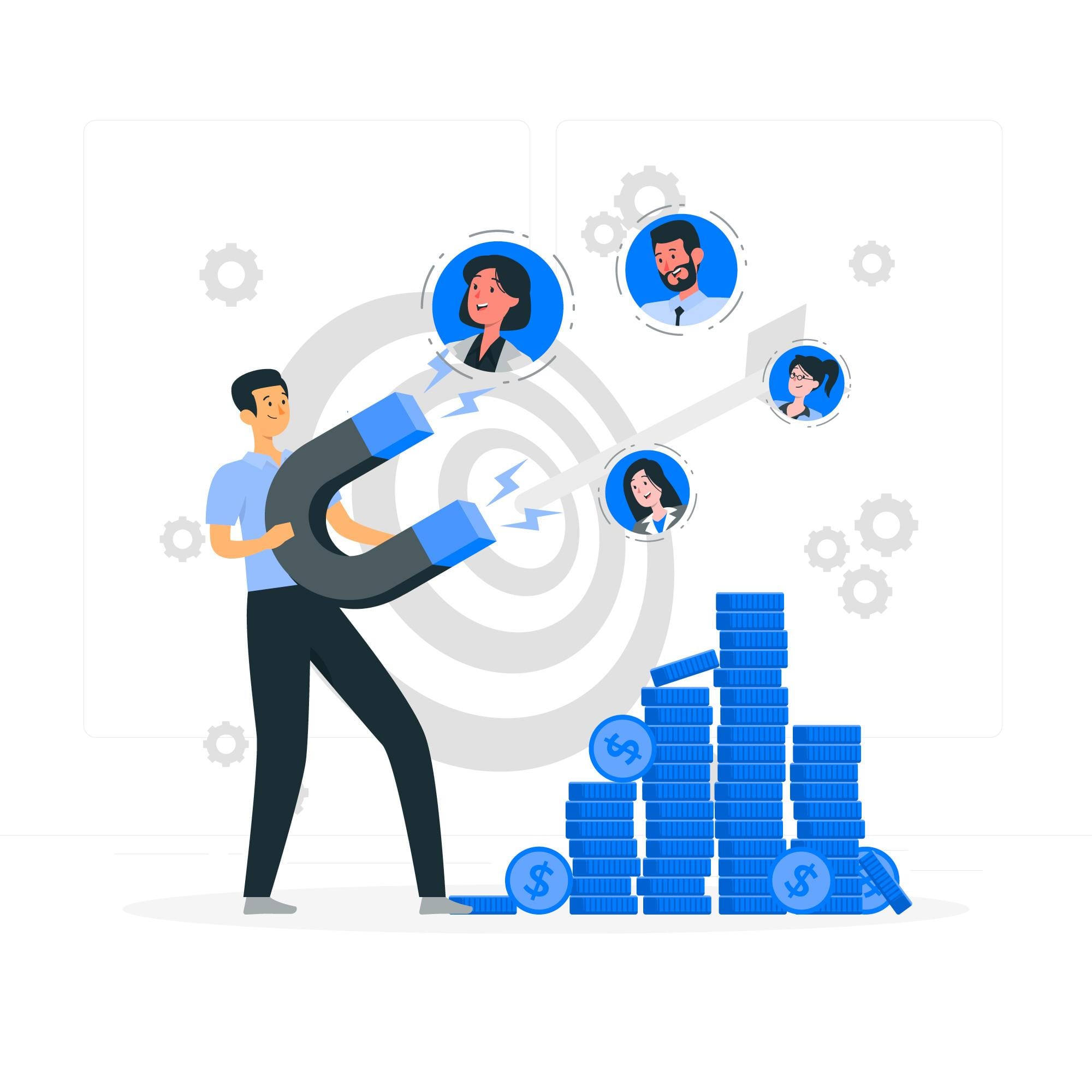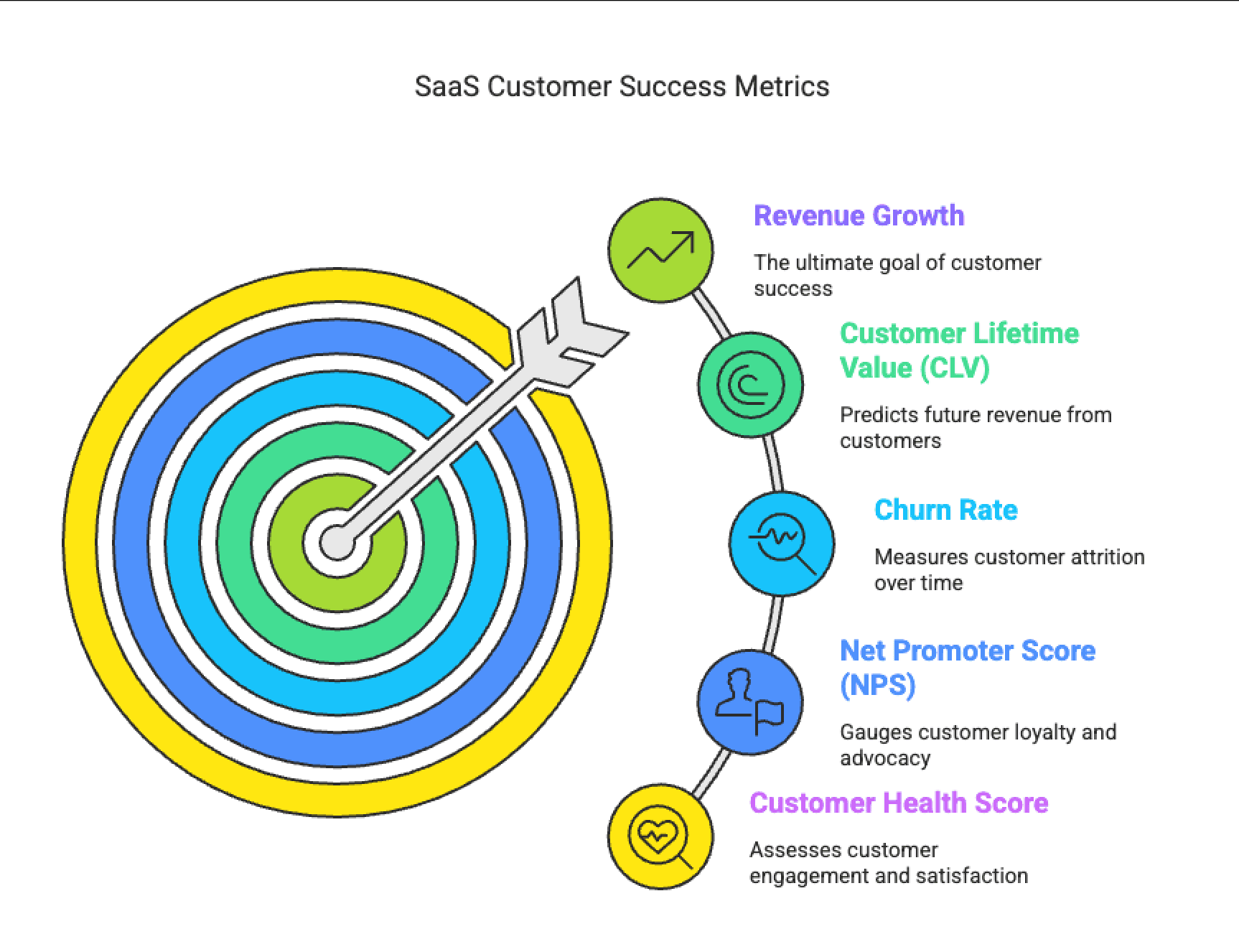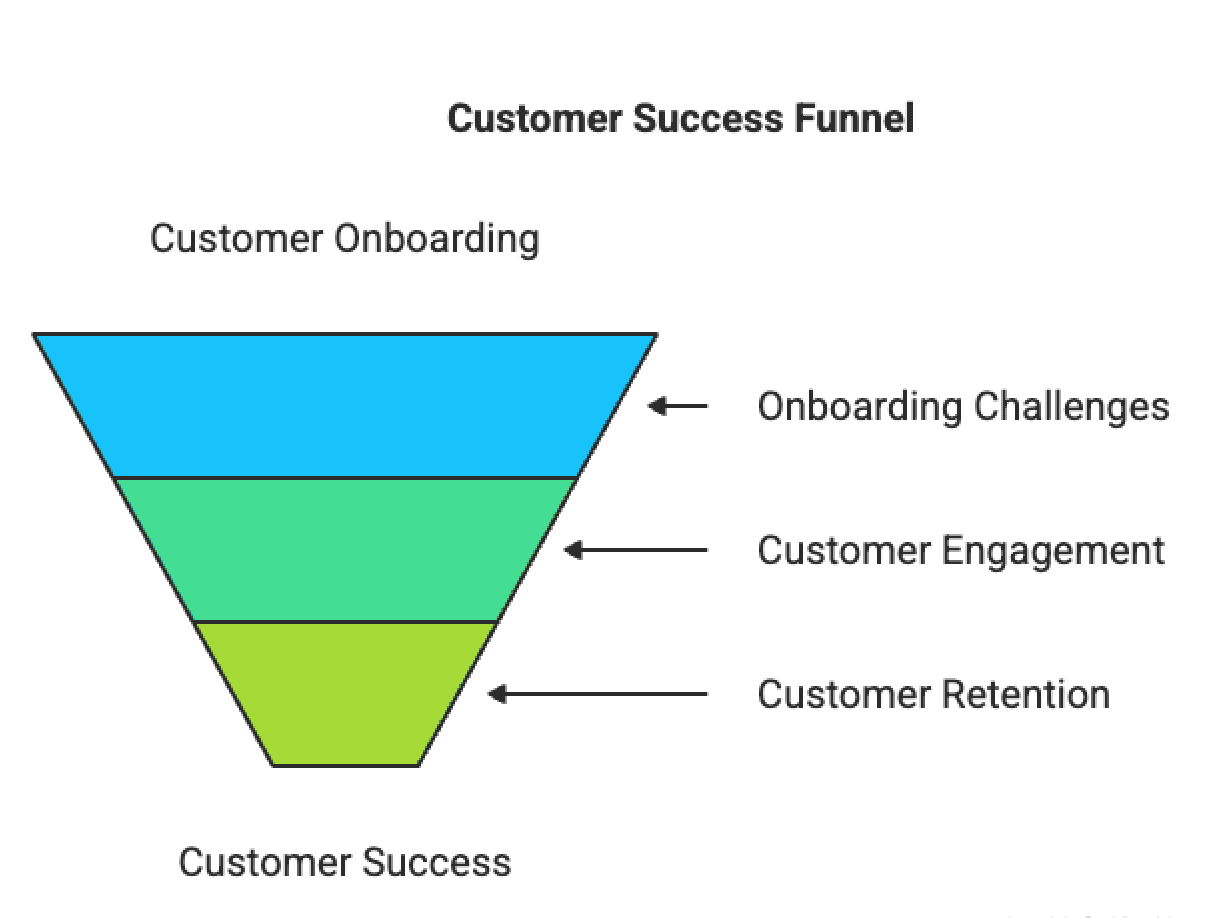Boost Growth with Proven SaaS Customer Success Tactics

Your team has built a great product—solid features, smooth interface, top-tier tech. But customers are still churning, adoption is slow, and renewals are uncertain.
Why? The issue often lies not in the product itself, but in the gap between product delivery and customer success. In a crowded market, having a great tool isn’t enough; customers need to succeed with it—and realize they are.
Enter SaaS Customer Success. It’s more than just onboarding or check-in emails; it’s a strategic engine that drives retention, expansion, and advocacy. To unlock its full potential, you need a clear, comprehensive approach.
This guide will walk you through everything you need to turn Customer Success into a growth driver—defining success, measuring impact, and overcoming challenges to ensure lasting customer success.
What is Customer Success in SaaS?
In SaaS, Customer Success is all about helping customers achieve their goals through proactive engagement. From seamless onboarding to continuous feedback and consistent value delivery, it builds customer satisfaction and loyalty. When customers succeed, your SaaS business thrives, making Customer Success a top priority.
Why Is Customer Success for SaaS Companies Important?
For SaaS companies, success goes beyond creating great software; it’s about ensuring customers get real value from it. As competition grows, focusing on Customer Success and a strong sales team is key to driving long-term growth and maximizing revenue.
Here’s why Customer Success is a game-changer for SaaS businesses:
1. Reduces Customer Churn
Customer churn quietly erodes SaaS revenue, but a solid customer success strategy can stop the bleed. Here's how:
Proactive Outreach: Solve issues before they start.
Tailored Support: Align with each customer’s goals.
Continuous Education: Share tips and updates that boost value.
Fast Resolution: Handle problems swiftly and effectively.
Value Reminders: Reinforce why your product matters.
2. Drives Sustainable Growth
Winning new customers is great—keeping them is better. Customer success drives real growth by turning users into loyal, long-term advocates:
Drives Expansion: Happy customers buy more.
Builds Loyalty: Consistent support keeps them around.
Inspires Advocacy: Satisfied users spread the word.
Cuts Costs: Retention beats constant acquisition.
3. Boosts Customer Lifetime Value (CLV)
Customer Lifetime Value fuels SaaS growth—and Customer Success is what makes it soar:
Boosts Retention: Support keeps customers coming back.
Increases Upsells: Engaged users are ready to level up.
Secures Renewals: Ongoing value leads to easy renewals.
Builds Loyalty: Strong ties mean lasting revenue.
4. Enables Customer-Centric Product Development
Customer Success is your front line to user insight—and a powerful voice in shaping your product:
Uncovers Feedback: Daily interactions reveal what works (and what doesn’t).
Surfaces Requests: Success teams relay ideas that drive smart updates.
Flags Bugs Early: Issues get caught before they escalate.
Guides Roadmaps: Real user input keeps development customer-focused.
5. Builds Competitive Advantage
A solid product is just the start. What truly sets companies apart is how they support their customers. Customer Success becomes your secret weapon:
Builds Loyalty: Support keeps customers coming back.
Creates Stickiness: Exceptional experiences make competitors less appealing.
Drives Differentiation: Personalized support highlights your unique value.
Boosts Reputation: Happy customers spread the word, building trust.
4 Actionable SaaS Customer Success Strategies to Drive Growth and Loyalty

To build a thriving Customer Success program, SaaS companies need to implement strategies that go beyond just troubleshooting issues. Below are four proven strategies to help you engage customers, reduce churn, and drive growth.
1. Proactive Onboarding and Training
A strong onboarding process ensures customers quickly understand the product’s value and feel confident using it. Here's how to do it effectively:
Personalized Onboarding Sessions: Tailor onboarding to the customer’s specific needs and goals to ensure a customized experience.
Guided Product Tours: Provide interactive walkthroughs to highlight key features.
Easy-to-Access Resources: Offer video tutorials, knowledge bases, and FAQ sections to help users get the most out of your product.
Early Check-ins: Follow up early to address any roadblocks or questions customers may have during the first few days or weeks.
2. Continuous Customer Engagement and Support
Customer engagement goes beyond onboarding—ongoing communication is key:
Regular Check-ins: Schedule calls to review progress and address concerns.
Proactive Resolution: Monitor usage to solve issues before they escalate.
Personalized Outreach: Share updates and tips tailored to their needs.
Feedback Loops: Collect insights to improve the customer experience
3. Leverage Data and Analytics for Insights
Data-driven decisions are crucial for optimizing Customer Success. Here’s how to leverage insights:
Monitor Usage: Track interactions to spot improvement areas.
Customer Health Scores: Flag at-risk customers for proactive outreach.
Feature Adoption: Identify valuable vs. underused features to guide engagement.
Satisfaction Metrics: Use NPS and CSAT to measure and improve satisfaction.
4. Foster Customer Advocacy and Community Building
Building a community of loyal customers turns satisfied users into powerful brand advocates. Here’s how:
Ask for Testimonials: Encourage happy customers to share their experiences.
Create Customer Communities: Build forums for users to connect, share, and learn.
Referral Programs: Reward customers for bringing in new business.
Showcase Success Stories: Highlight customer wins through blogs, social media, and webinars.
How to Put Customer Success into Practice and Drive Growth?

Operationalizing Customer Success means integrating it across all business functions, from onboarding to support, ensuring customer-facing teams work together to maximize value for both customers and the business. This alignment drives long-term success and stronger relationships.
1. Define Customer Success Metrics and KPIs
To operationalize Customer Success, define success for your customers and establish key metrics to track progress. This helps align efforts with business goals. Key steps include:
Customer Health Score: Track engagement, usage, and support tickets to spot at-risk customers.
Net Promoter Score (NPS): Measure loyalty and satisfaction to assess how well your product meets needs.
Customer Lifetime Value (CLV): Calculate expected revenue from a customer over their relationship.
Churn Rate: Monitor cancellations to gauge retention.
2. Create Cross-Functional Alignment
Customer Success thrives on cross-department collaboration, especially with product teams. To align teams and deliver value, follow these steps:
Sales & Marketing Collaboration: Align messaging with product capabilities to set accurate expectations.
Product & Development Coordination: Share feedback from Customer Success to shape the product roadmap.
Customer Support Collaboration: Ensure seamless assistance by aligning with support teams for quick issue resolution.
3. Implement Technology and Tools
The right technology simplifies Customer Success management by automating tasks and providing insights into customer behavior. Key tools to consider include:
CRM Software: Track interactions, manage accounts, and automate follow-ups.
Customer Success Platform: Use tools like Gainsight or Totango to monitor health scores and usage.
Help Desk & Support Tools: Streamline customer queries with platforms like Zendesk or Intercom.
Analytics Tools: Track engagement and usage with tools like Google Analytics or Mixpanel.
4. Develop Standardized Processes and Playbooks
To scale Customer Success, establish clear, repeatable processes. Focus on:
Onboarding Process: Create standardized workflows to set new customers up for success.
Customer Health Protocols: Set guidelines for proactively reaching out to at-risk customers.
Renewal & Upsell Playbooks: Develop playbooks to identify opportunities for renewals and upsells.
5. Regular Training and Development
As you scale, prioritize ongoing training for your Customer Success team to keep them equipped with up-to-date skills and knowledge. Focus on:
Product Knowledge: Ensure deep familiarity with product features and customer pain points.
Customer Interaction Skills: Train in communication, problem-solving, and empathy.
Data-Driven Decision Making: Teach the team to use data to personalize interactions and spot opportunities.
How To Measure Customer Success in SaaS?

Measuring Customer Success is vital for SaaS growth and retention. Tracking the right metrics helps identify areas for improvement, reduce churn, and optimize experiences. Here are key methods and metrics to measure Customer Success in SaaS:
1. Customer Health Score
A Customer Health Score is a comprehensive metric that indicates the overall health of a customer relationship, taking into account multiple factors like product usage, engagement, and support history. Here's how to use it effectively:
Product Usage: Monitor how often and in what ways the customer is using your product. Low usage can signal dissatisfaction or disengagement.
Customer Engagement: Track interactions such as log-ins, feature adoption, and participation in training sessions or webinars.
Support Interactions: Keep an eye on how frequently customers contact support and the nature of their issues. Frequent issues may indicate problems with the product or customer experience.
Feedback and Surveys: Include data from customer surveys, such as Net Promoter Score (NPS) or Customer Satisfaction Score (CSAT), to gauge sentiment.
A healthy score means the customer is likely to renew or even expand their subscription, while a low score may signal risk of churn.
2. Net Promoter Score (NPS)
Net Promoter Score (NPS) measures customer loyalty by asking, "On a scale of 0-10, how likely are you to recommend our product?" Respondents are categorized into:
Promoters (9-10): Loyal, likely to refer others.
Passives (7-8): Neutral, not actively engaged.
Detractors (0-6): Unhappy, may not renew or influence others negatively.
3. Churn Rate
Churn rate is a critical metric that measures the percentage of customers who cancel their subscription within a specific period. This is a direct reflection of customer dissatisfaction or unmet needs. Here’s how to calculate and analyze churn:
Calculate Churn Rate:
Formula: (Number of customers lost during a period ÷ Number of customers at the start of the period) × 100
Analyze Trends: A high churn rate can indicate issues with your product, customer support, or overall value proposition.
Segment Churn Data: Look at churn by customer segments (e.g., by size, industry, or plan type) to uncover patterns and areas for improvement.
Reducing churn is essential to sustainable growth, as retaining existing customers is often more cost-effective than acquiring new ones.
4. Customer Lifetime Value (CLV)
Customer Lifetime Value (CLV) measures the total revenue a customer is expected to generate throughout their relationship with your company. This metric helps you understand the long-term value of retaining customers and investing in Customer Success initiatives. Here’s how to calculate and use CLV:
Calculate CLV:
Formula: (Average Revenue per Customer × Customer Lifespan) - Customer Acquisition Cost (CAC)
Increase CLV: Focus on initiatives that boost engagement and reduce churn, such as upselling, cross-selling, and improving product adoption.
Segment by CLV: Look at CLV across different customer segments to understand which types of customers are most valuable, helping you target your efforts more effectively.
Higher CLV means that customers are deriving ongoing value from your product, justifying the investment in Customer Success.
What Are The Common Challenges and Solutions in SaaS Customer Success?

Customer Success is key to SaaS growth, but it comes with challenges. From smooth onboarding to reducing churn, obstacles can impact the customer experience. By addressing these early and implementing solutions, SaaS companies can turn challenges into opportunities. Here are common hurdles and their solutions:
1. Challenge: Onboarding Difficulties
A poor onboarding experience is one of the leading causes of churn in SaaS. If customers don’t understand how to use the product effectively from the start, they may quickly lose interest or abandon the product altogether.
Solution:
Personalized Onboarding: Tailor onboarding processes based on customer goals and needs. Provide a step-by-step guide to key features and functions.
Automated Tutorials: Use in-app walkthroughs and video tutorials to demonstrate product value and help customers get up to speed quickly.
Dedicated Support: Assign a customer success manager (CSM) for the initial phase to provide real-time assistance and ensure that customers don’t face challenges on their own.
By offering a tailored, hands-on approach to onboarding, you increase the chances of successful adoption.
2. Challenge: Customer Engagement and Retention
Keeping customers engaged over the long term can be difficult, especially when customers stop using your product or fail to see its ongoing value. Lack of engagement can result in churn, even if the product is fundamentally strong.
Solution:
Proactive Outreach: Regular check-ins from customer success managers (CSMs) help gauge satisfaction and provide assistance before customer issues arise.
Data-Driven Engagement: Use product usage data to identify when customers are disengaging or underutilizing features. Reach out with personalized recommendations or new features they may benefit from.
Customer Education: Continuously educate customers on how to make the most of your product through webinars, content, and new feature releases.
By staying engaged with customers and guiding them to deeper product use, you can maintain long-term relationships and increase retention.
3. Challenge: Managing Customer Expectations
SaaS products often have complex features or require some time for customers to fully realize their potential. Misaligned expectations can lead to frustration, dissatisfaction, and churn.
Solution:
Clear Communication: Set proper expectations from the outset by explaining what the product can and can’t do. This ensures that customers understand the value and potential limitations.
Regular Updates: Keep customers informed about product changes, improvements, and new features. Transparency about the product roadmap helps align expectations. Customer success plays a key role in maintaining this transparency.
Feedback Loops: Actively seek customer feedback through surveys or direct conversations, and use it to shape product development and address concerns.
By managing expectations and keeping open communication, you can minimize misunderstandings and improve overall customer satisfaction.
4. Challenge: Scaling Customer Success Teams
As a SaaS company grows, it can be difficult to scale the Customer Success team without sacrificing the quality of service. Smaller teams may struggle to maintain personal relationships with each customer, leading to gaps in support and potentially lost customers.
Solution:
Invest in Technology: Use Customer Success platforms to automate routine tasks, track customer health scores, and monitor engagement. This allows teams to focus on high-priority tasks without losing sight of the broader customer base.
Segment Customers: Prioritize customers based on factors like revenue, usage, and potential for growth. Create tiered support strategies, focusing on high-value customers while providing scalable resources for others.
Train and Enable Teams: Provide your Customer Success team with the tools and training they need to be more efficient and effective in managing customer relationships.
With the right tools and strategies, you can scale your Customer Success efforts without sacrificing quality.
Supercharge Your Sales with Personalized Demos from SmartCue
SmartCue transforms your sales and marketing efforts with personalized, interactive product demos that engage prospects like never before. Forget boring videos and static content—SmartCue allows you to create dynamic demos tailored to your audience's needs, driving higher conversions and reducing time-to-sale.
With seamless integrations, easy-to-use tools, and data-driven insights, SmartCue ensures that every demo is optimized for success. Ready to convert more leads and supercharge your demos? Try SmartCue today and see the difference! Get started with a 14-day free trial!
Conclusion
Customer Success has redefined the SaaS game. It’s not just about selling software anymore—it’s about ensuring your customers thrive. In today’s competitive landscape, the key isn’t just delivering a product; it’s building lasting relationships that keep customers engaged. Challenges like churn and resource limitations might seem daunting, but with the right strategies, they’re manageable. By embracing Customer Success, you’re not just closing deals—you’re forming partnerships that fuel growth for both sides. It's all about long-term success together!
Frequently Asked Questions
What is the difference between customer success and customer service in SaaS?
In SaaS, customer service typically handles reactive responses to customer inquiries or difficulties, including technical support. On the other hand, customer success is a proactive approach aiming to foster customer satisfaction and success through personalized onboarding, continual education, and efficiently addressing their needs based on their specific business goals.
How often should a SaaS company review its customer success strategies?
Ideally, a SaaS company should undertake a thorough review of its customer success strategies every quarter. This allows CS managers to gain ongoing understanding of how effectively the strategies are performing, any issues or bottlenecks that are arising, and opportunities for refining these strategies to enhance customer satisfaction.
What are some common tools used in SaaS customer success?
Customer success tools vary widely based on the requirements of the business. Commonly used tools include Customer Relationship Management software like Salesforce or HubSpot, Ticketing Systems like Zendesk, Data Analytics tools like Tableau, and dedicated customer service tools and Customer Success Platforms like Gainsight or Totango.
How can small SaaS companies implement effective customer success strategies with limited resources?
Small SaaS companies can effectively implement customer success strategies by focusing resources on key impact areas, leveraging automation to streamline processes, and prioritizing customers with the highest potential value. Utilizing customer success software can also help manage customer interactions and track product usage efficiently.
Can customer success influence product development in SaaS?
Yes, customer success can significantly influence product development in SaaS businesses. As the customer success team works directly with clients, they gather valuable feedback concerning product features, user experience, and customer needs that can inform product enhancements and lead to continuous innovation.
How does customer success impact overall business growth in SaaS?
In a SaaS context, customer success directly impacts overall business growth by enhancing customer retention and fostering upselling opportunities, both crucial for recurring revenue and revenue growth. Further, satisfied customers often serve as brand advocates, contributing to new customer acquisition. Hence, effective customer success strategies are integral to driving sustainable business growth.
Comments
Your comment has been submitted successfully!